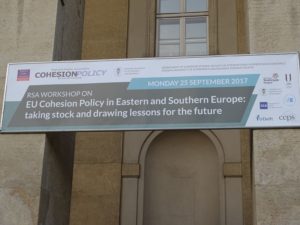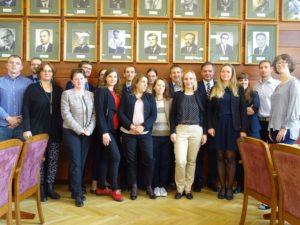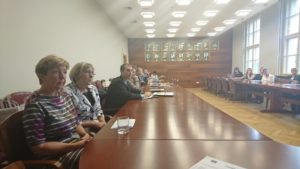Report on the RSA Workshop on EU Cohesion Policy in Eastern and Southern Europe: Taking Stock and Drawing Lessons for the Future

Report on the RSA Workshop on ‘EU Cohesion Policy in Eastern and Southern Europe: Taking Stock and Drawing Lessons for the Future’
By Marcin Dabrowski, Delft University of Technology, Ida Musialkowska, Poznan University of Economics, Piotr Idczak, Poznan University of Economics and Oto Potluka, University of Basel
This 10th workshop of the RSA Research Network on EU Cohesion Policy focused on the implementation and challenges of the Cohesion Policy in Eastern and Southern Europe.
Regions in the EU’s Eastern and Southern peripheries tend to perform badly across many rankings from economic development, to quality of government, social justice and innovation potential, despite the fact that the vast majority of EU structural funding has been spent in these countries. However, the picture is differentiated. These countries followed different development trajectories and reacted differently to the economic crisis. Some of them still struggle, others thrive, others still, after years of structural transformation, are stuck in a middle-income trap. They adopted different strategies under EU Cohesion Policy and also followed different Europeanisation pathways. Their experiences, successes and failures are a valuable source of lessons for the future of the policy and for current and prospective candidate countries. While there have been various attempts to learn from others in the policymaking sphere – e.g. in European Territorial cooperation, EU-wide networks (e.g. IQ-Net, ERRIN), or in the context of peer-to-peer and twinning initiatives – academic research has not yet adequately reflected on the lessons that can be drawn from EU Cohesion Policy implementation for the future of the policy and future enlargements.

Therefore, during the workshop the following questions were addressed:
- How have the Europeanisation pathways and the approaches towards regional / Cohesion Policy planning and implementation evolved over time and with what impact in terms of policy performance?
- What is the legacy of EU Cohesion Policy in terms of institutional innovation and administrative capacity-building?
- What are the outcomes in terms of sustainability of the policy’s implementation?
- Which countries and regions are the most/least successful in the implementation of Cohesion Policy and why (what are key-factors of success, what are the barriers)?
- What have been the main territorial impacts from the implementation of EU Cohesion Policy in a given region/country?
- What lessons can be drawn from the successes and failures of Cohesion Policy in the Eastern, South Eastern, and Southern periphery and to what extent can these lessons be applied to candidate countries?
- What have been the main results/impacts from the implementation of the European Territorial Cooperation in a given cross-border/transnational region?
- What can EU regions learn from the candidate countries in terms of joint projects executed mainly through cross-border cooperation or under Instrument for Pre-Accession?
- What is the role of EU funding for the Eastern, South Eastern, and Southern regions in shaping European identities and perceptions of the European integration?
- What lessons can be drawn from the experience of the main recipients of EU funds for Cohesion Policy after 2020?
The workshop was kicked off by the welcome by the Poznań University of Economics and Business’ representatives: Elżbieta Gołata (Vice-rector for research and international cooperation), Maciej Szymczak (dean of the Faculty of International Business and Economics), Ewa Małuszyńska (Chair of the Department of European Studies) and Ida Musiałkowska (on behalf of RSA RN on EU Cohesion Policy and local organisers).

Eduarda Marques da Costa (University of Lisbon) opened the workshop with insightful presentation of European regions repeating the same paths at different speeds. She pointed out the different needs and prerequisites for regional development and growth (following the remarks of prof. Ewa Małuszyńska), and presented the effects of the policy and their variation depending on the model of impact measurement, highlighting challenges between the territorial dimension of Cohesion Policy, spatial and strategic planning and Cohesion Policy cycle. She underlined social cohesion importance and advocated for more integrated system of indicators and adjustment of territorial indicators to those existing in Cohesion Policy.
The first session; “Convergence at regional and micro level. Countries’ experiences with regional and urban policy-making in the Cohesion Policy”, was opened by Panagiotis Liargovas (University of Peloponnese), who presented a co-authored paper (with Stavroula Kratimenou) measuring real convergence or divergence of the 28 EU member-countries using two approaches, the first based on the coefficient of variation and the second based on classifications based on the values of a quality of life index. The results showed three groups of countries with a higher, equal and lower than average quality of life composite index, as calculated by the authors. The groups comprised mainly the same countries over the period of time 1990-2015, in the first mainly so-called old member states were found, in the second only one country per analysed sub-period was classified (Ireland, UK, Greece) and in the third – the new member states were classified. In general, a drop in the inequality between the EU member states and real convergence was observed. The paper was concluded by presenting a policy proposal to channel financing for the countries underperforming in terms of quality of life.
Judit Kalman (Hungarian Academy of Sciences, Centre for Economic and Regional Studies) discussed the effects of EU-funds on territorial cohesion by examining public and private resources for regional development in the least-developed and most deprived micro-regions (NUTS 3 regions) of Hungary. Her results showed that the majority of EU funds were absorbed in more developed regions. Suggesting, there is a need to focus on the most deprived areas in order to reduce the negative effects of unbalanced development, but also that new programs should be more complex, integrated and require greater coordination and cooperation amongst stakeholders.
In the last presentation in the session Dorota Kamrowska-Załuska and Hanna Obracht-Prondzyńska (Gdańsk University of Technology) asked whether urban regeneration embedded of in the regional programmes and EU Cohesion Policy is an instrument which can help to strengthen planning and governance within urban functional areas in Poland. They concluded that the role of regeneration processes is expected to increase in Poland and advocated for decreased dependence on EU-funded schemes and the introduction of new types of development schemes based on partnership that are better able to create competitive advantage and thematic and spatial concentration.

The second session; “Governance, political factors and impact on the implementation of the Cohesion Policy”, was opened by Monika Banaszewska (Poznań University of Economics and Business), who presented the findings of research done with Ivo Bischoff (University of Kassel) on the possible impact of EU funds on re-elections at local level in Poland. The main conclusion was that the use of EU funds by the municipalities does not have a significant effect on mayoral elections, except for municipalities with a high share of the EU-friendly and highly educated population.
Györgyi Nyikos and Gábor Soós (Hungarian National University of Public Service) delivered a paper on the Hungarian experience of using Cohesion Policy and its future prospects. They presented impact of this policy on macroecnomic data such GDP and GDP per capita and the labour market in pre and post-crisis periods. They found that in Hungary, experiences with EU funds absorption are rather positive, but due to the crisis the effects of Cohesion Policy are hardly detectable in the years 2007-2013. The current programming period seems to be more promising in terms of bringing more positive results of the use of EU funds. Much depends on the quality of projects selected, cooperation with financial institutions with regard to the use of e.g. financial instruments and the general effects of integration processes in the EU.
Sylwia Borkowska-Waszak (University of Strathclyde, European Policies Research Centre) discussed the conceptual framework of her studies on the role of political factors in Cohesion Policy implementation based on the case of Integrated Territorial Investments (ITI) in Poland. She decided to investigate the contrasting case of two Polish regions: Śląskie and Lubelskie that decided to take different approaches to the implementation of ITI in order to understand and present the process of implementation from the perspective of local and regional actors
In the final session; ”Institutional and sectoral approaches towards the Cohesion Policy”, Monika Matusiak (European Commission) presented findings from her research and practical exchanges with partners from EU neighbouring countries in the area of smart specialisation. She focused on institutional readiness and institutional discovery process for smart specialisation in Eastern and South-Eastern EU, candidate and neighbourhood countries, pointing out that these countries are willing to learn from EU experiences and the design the system. This is the first step towards the implementation of the smart specialisation strategies. However, the role of political factors, such as e.g. political will to implement the designed system, is crucial in order to advance to the next stage of the public policy cycle.
Gergő Medve-Bálint and Vera Ščepanovič (Hungarian Academy of Sciences/ European University Institute) revealed the results of their research analyzing the promotion of foreign investments through EU funds in the Eastern member states. Drawing on the comparison of automotive sector in Poland and Romania in the 2007-13 programming period. They found that these states have preserved their ability for developmental action because the EU has broadened their policy space through Cohesion Policy. Until the entry to the EU, the majority of investment incentives came from public budgets, while in recent years they have been increasingly provided via the EU funds. These transnational resources have partly alleviated domestic distributional conflicts and allowed governments to support more and more varied investment projects including enhanced support to domestic firms. The findings did not confirm the anticipated cross-country differences in the distribution of EU funds by firm ownership. Domestic automotive firms received the majority of the funds in Romania, while in Poland three quarters of the EU grants were secured by multinationals. Apart from this rather fundamental difference, the two countries shared similar practices. As a result of these findings, it was argued that future research should explore the relationship between state capacity and the implementation of transnational industrial policy.
Finally, Oto Potluka (University of Basel, CEPS) presented a paper co-authored with Martin Spacek and Jiri Remr (Slovak University of Technology Comenius University in Bratislava, Institute for Evaluations and Social Analyses) on the role of Non-Governmental Organisations (NGOs) as partners in the programming of Cohesion Policy. Drawing on a survey of Czech organisations, he pointed out the main obstacles to the participation of NGOs and discussed the consequences of this involvement for the management of the civil society sector. Despite the fact that the majority of the organisations surveyed claimed that partnership was beneficial for all, they negatively assessed this form of cooperation in the partnership and the way the decisions were made. Particular interests and the fragmentation of NGOs were cited as one of the main obstacles to the implementation of the partnership principle, while communication and low capacities were further weak points.
In sum, as highlighted in the concluding remarks by Oto Potluka, despite existing disparities, Cohesion Policy works and Europe is becoming more cohesive, but there are still many challenges to be tackled in the forthcoming financial perspective and many unanswered questions posed during the workshop. The speakers provided important findings that should be taken into account by policy-makers in the programming of post 2020 Cohesion Policy, hopefully via the publications stemming from the workshop.